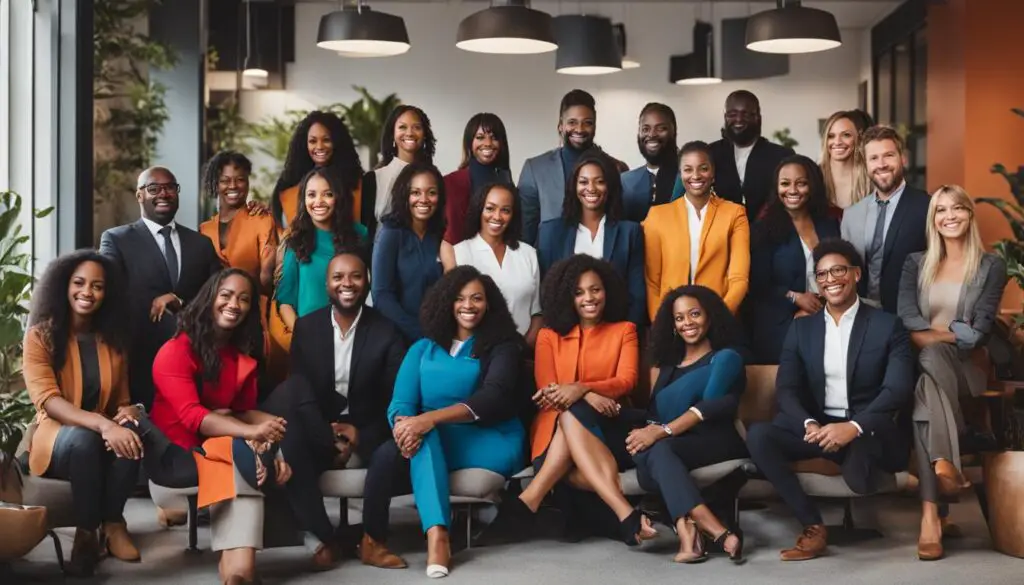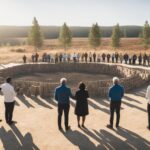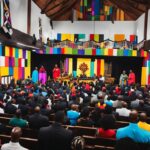Embracing unity and diversity is crucial in fostering inclusive communities and workplaces across the US. By celebrating the uniqueness of every color, culture, and identity, we can create a world where all individuals are heard, valued, and cherished. The power of unity in diversity transcends borders and breaks down barriers, creating a sense of belonging and understanding.
Diversity and inclusion are not just buzzwords; they are the foundation of a vibrant and harmonious society. When we come together to promote diversity, we create spaces where everyone feels welcome, respected, and valued for who they are. By embracing diversity, we open the doors to new ideas, perspectives, and innovations.
The beauty of diversity lies in the richness of various cultures, languages, and traditions. Embracing diversity not only fosters unity but also enriches our global community. By appreciating and valuing diverse experiences, talents, and perspectives, we promote innovation and strength through diverse perspectives. Inclusivity serves as the key to compassion and empathy, creating spaces where every voice is welcomed and valued.
Key Takeaways:
- Celebrating diversity creates a sense of belonging and understanding.
- Diversity and inclusion are crucial for vibrant and harmonious societies.
- Embracing diversity fosters unity and promotes innovation.
- Inclusivity is the key to compassion and empathy.
- Valuing diverse experiences and perspectives strengthens our communities.
The Beauty of Diversity and Inclusivity
The beauty of diversity lies in the richness of various cultures, languages, and traditions. Embracing diversity not only fosters unity but also enriches our global community. By appreciating and valuing diverse experiences, talents, and perspectives, we promote innovation and strength through diverse viewpoints.
Inclusivity serves as the key to compassion and empathy, creating spaces where every voice is welcomed and valued. Whether in diverse communities, workplaces, or educational institutions, embracing cultural and ethnic diversity allows us to learn from one another and expand our horizons.
“Diversity is not about how we differ. It is about embracing one another’s uniqueness.” – Ola Joseph
When we celebrate diversity, we pave the way for greater understanding and acceptance. Cultural diversity fuels creativity and opens up new possibilities, encouraging us to see the world through different lenses. It challenges us to question our assumptions, broaden our perspectives, and find common ground despite our differences.
In a world where unity and diversity go hand in hand, we have the opportunity to build harmonious relationships and foster a sense of belonging for all. By actively creating inclusive spaces and promoting equal opportunities, we can unlock the full potential of individuals from diverse backgrounds, leading to stronger communities and a more prosperous society.
Embracing Diversity as a Source of Strength
Embracing diversity means recognizing that each person brings unique experiences, talents, and insights to the table. When individuals from diverse backgrounds come together, a wealth of knowledge and expertise is unleashed. This synergy fuels creativity, innovation, and problem-solving.
- Collaboration across cultures leads to a broader range of ideas and approaches.
- Diverse perspectives challenge conventional thinking and foster more effective decision-making.
- Cultural diversity enriches artistic expression, literature, music, and other creative outlets.
- Ethnic diversity enhances culinary traditions, fashion, and cultural celebrations.
By embracing diversity and appreciating its beauty, we create a world where unity flourishes in the cultural tapestry of our shared humanity.
| Benefits of Embracing Diversity and Inclusivity |
|---|
| Promotes creativity and innovation |
| Enhances problem-solving abilities |
| Fosters cultural understanding and empathy |
| Strengthens communities and workplaces |
| Encourages personal growth and learning |
Embracing diversity and inclusivity is not just a moral imperative; it also makes practical and economic sense. In a rapidly globalizing world, organizations and societies that prioritize diversity are better equipped to navigate complex challenges, adapt to change, and thrive in an increasingly interconnected and diverse environment.

Embracing Diversity in the Workplace
Creating an inclusive workplace environment is crucial in today’s diverse world. By embracing diversity and promoting equal opportunities, organizations can foster unity and tap into the collective potential of their workforce. Embracing diversity goes beyond hiring individuals with different backgrounds; it involves breaking down barriers, practicing empathy, open-mindedness, and cultural sensitivity.
By welcoming diverse voices and perspectives, organizations can create a space for learning, understanding, and building strong relationships based on mutual respect. Embracing diversity in the workplace not only enhances employee engagement but also drives innovation and success.
Promoting Unity through Inclusive Leadership
Inclusive leadership plays a pivotal role in promoting diversity in the workplace. Leaders who value and embrace diversity inspire their teams to collaborate, respect one another, and recognize the unique contributions of each individual. By fostering a culture of inclusivity, leaders empower employees to bring their authentic selves to work, which leads to increased creativity and problem-solving.
Through effective communication, transparent decision-making, and promoting an inclusive work environment, leaders create a sense of belonging among their diverse teams. Inclusive leaders prioritize equal opportunities, encourage diverse perspectives, and champion the value of unity in the workplace.
Fostering Collaboration among Diverse Teams
Collaboration among diverse teams is a powerful catalyst for innovation and success. When individuals from different backgrounds come together, they bring a variety of perspectives, experiences, and skills to the table. This diversity of thought leads to creative solutions and breakthrough ideas that can propel organizations forward.
However, fostering collaboration among diverse teams requires more than just assembling a group of individuals with different backgrounds. It involves creating an inclusive and safe environment where everyone feels comfortable sharing their ideas and opinions, without fear of judgment or exclusion. When individuals feel valued and respected for their contributions, they are more likely to work together harmoniously, leveraging their diverse skills and experiences to achieve common goals.

The Benefits of Embracing Diversity in the Workplace
| Benefits | Impact |
|---|---|
| Enhanced creativity and innovation | Diverse perspectives lead to fresh ideas and unique solutions. |
| Improved problem-solving | Diverse teams bring different approaches and experiences, leading to more comprehensive problem-solving. |
| Increased employee engagement and retention | When employees feel valued and included, they are more likely to stay with the organization and give their best. |
| Expanded market reach | A diverse workforce can better understand and cater to a wide range of customers and clients. |
| Enhanced company reputation | Organizations that prioritize diversity and inclusion are seen as more progressive, attracting top talent. |
Embracing diversity in the workplace is more than just a moral imperative; it is a business necessity. By valuing and promoting diversity, organizations can unlock the full potential of their workforce, foster inclusivity, and drive long-term success.
The Power of Unity in Faith
Unity and diversity are not only present in the secular world but are also deeply rooted in religious and spiritual practices. Despite diverse beliefs and doctrines, different faiths place a strong emphasis on fostering unity among their followers, recognizing its significance in building cohesive communities. The leadership and clergy within religious institutions play a crucial role in nurturing and promoting this sense of unity.
The leaders and clergy members provide guidance, support, and moral direction to their respective communities. They serve as beacons of unity, inspiring individuals to come together and celebrate their shared values. Through their teachings, they encourage peaceful coexistence, understanding, and respect, regardless of religious differences.
“The essence of religion is to create loving bonds between human beings. In our diverse world, it is crucial for leaders and clergy to foster unity and bridge the gaps that may divide us,” says Reverend Emily Anderson, a prominent leader known for her efforts in promoting interfaith dialogue and understanding.
“The power of unity in faith is not only transformative within religious communities, but it also has a profound impact on society as a whole. When individuals from different faiths come together, they reinforce the notions of peace, compassion, and solidarity,”
says Rabbi David Cohen, a respected spiritual leader advocating for interreligious harmony.
In religious worship practices, individuals gather to express devotion, gratitude, and to seek spiritual fulfillment. Shared rituals and practices serve as unifying factors, creating an emotional and spiritual bond among the worshipers. These rituals transcend individual beliefs and promote a sense of togetherness and interconnectedness.
Sacred texts, such as the Bible, Quran, Torah, and others, are revered by followers of different religions. Although the texts may differ, the underlying message of unity, love, compassion, and faith resonates across diverse communities. These sacred texts serve as a source of inspiration, guidance, and wisdom for their respective followers.

Denominations and sects within religious traditions reflect the diversity of beliefs and interpretations within a broader faith community. While differences in beliefs and practices may exist, they should be seen as opportunities for dialogue, understanding, and growth. Unity can be found even among denominations and sects as they share a common foundation and an overarching commitment to faith and spirituality.
Leadership and Clergy: Fostering Unity in Faith Communities
The role of leadership and clergy in fostering unity within faith communities cannot be overstated. They engender a sense of shared purpose, promote open dialogue, and facilitate opportunities for interfaith collaboration and engagement. By embracing diversity and ensuring inclusivity, religious leaders create spaces where all individuals feel welcome and valued.
Reverend Sarah Johnson, a prominent leader and advocate for unity in faith communities, believes that leadership and clergy must lead by example:
“It is our responsibility to promote unity and embrace diversity within our faith communities. We must strive to build bridges, dispel prejudices, and promote understanding among different faith traditions. By doing so, we contribute to the greater good of society and create a world rooted in love, acceptance, and unity,”
she shares.
Through community and outreach programs, faith institutions play an active role in addressing social issues, promoting social justice, and providing support to marginalized communities. These initiatives exemplify the commitment of religious communities to serve as catalysts for positive change, fostering unity through compassion, empathy, and outreach.
Sacred Spaces: Architectural and Artistic Expressions of Unity
The architectural and artistic features of religious spaces reflect the unity and diversity within faith communities. Whether it is the intricate designs of a mosque or the celestial motifs of a cathedral, these architectural expressions showcase the cultural richness, creativity, and devotion of different religious traditions.
Rabbi Maya Goldberg, an expert in religious art and architecture, highlights the significance of these expressions:
“The beauty of architectural and artistic features lies in their ability to unite people, not merely as spectators, but as active participants in their faith. These ethereal spaces inspire a sense of awe, promoting a deeper connection with the Divine and establishing a collective identity,”
she explains.
When individuals come together within these sacred spaces, they experience a sense of belonging and unity. The architectural elements and artistic representations serve as visual reminders of shared beliefs, collective worship, and the enduring power of faith.
Celebrating Sacred Texts
Sacred texts hold great significance in many religious traditions. While these texts may vary across different faiths, they often serve as a unifying force, providing moral and spiritual guidance to believers. The diversity of sacred texts allows for a deeper understanding of various religions, fostering respect and unity among individuals of different faiths.
History and Origins
The origins of sacred texts can be traced back to ancient times, where they were written and passed down through generations. These texts encapsulate the beliefs, teachings, and stories that form the foundation of religious practices.
Beliefs and Doctrines
Sacred texts outline the core beliefs and doctrines of a religious tradition. They provide a framework for understanding the world, the purpose of life, and the moral principles to guide adherents in their daily lives.
Sacraments and Rituals
Sacred texts often prescribe specific sacraments and rituals that are central to religious practices. These rituals serve as a means of connecting with the divine, expressing devotion, and fostering a sense of community among believers.
Leadership and Clergy
The interpretations and teachings of sacred texts are often guided by religious leaders and clergy. These individuals play a vital role in elucidating the messages within the texts and providing guidance to their respective communities.
Worship Practices
Worship practices, including prayer, meditation, and communal gatherings, are deeply rooted in sacred texts. They provide believers with a platform to express their devotion, seek spiritual fulfillment, and strengthen their connection to the divine.
Denominations and Sects
Within various religious traditions, there are often denominations and sects that represent different interpretations and practices. These differences, influenced by the interpretation of sacred texts, contribute to the diversity within religious communities.
Community and Outreach
The principles outlined in sacred texts often promote compassion, justice, and community welfare. Many religious communities engage in outreach programs to address social issues, promote inclusivity, and provide support to those in need.
Architectural and Artistic Features
The influence of sacred texts can be seen in the architectural and artistic features of religious structures. From intricately designed temples and mosques to beautifully painted religious art, these artistic expressions reflect the reverence and devotion inspired by the texts.
Contemporary Issues and Challenges
Interpreting and applying the teachings of sacred texts in the context of contemporary issues can be both a source of unity and a challenge. Religious communities often grapple with finding a balance between tradition and adapting to societal changes.
| Sacred Text | Religious Tradition |
|---|---|
| Bible | Christianity |
| Quran | Islam |
| Torah | Judaism |
| Vedas | Hinduism |
| Guru Granth Sahib | Sikhism |
| Tripitaka | Buddhism |
Celebrating the diversity of sacred texts enriches our understanding of various religions, fostering respect and unity among individuals of different faiths. Through the shared reverence for these sacred texts, we can embrace the interconnectedness of humanity and cultivate a world that values diversity and promotes harmony.

The Role of Community and Outreach
Communities play a vital role in fostering unity and diversity. Through community and outreach programs, individuals come together to address societal issues and promote inclusivity. These initiatives create a sense of belonging and allow for the celebration of diverse backgrounds, building bridges of compassion and understanding.
Embracing Unity and Diversity Through Community
Community is the foundation upon which unity and diversity thrive. It is within the community that we find support, acceptance, and the opportunity to connect with people from different walks of life. By embracing unity and diversity within our communities, we create spaces that empower individuals and promote a sense of belonging.
“Community is where unity and diversity intersect. It’s a place where we learn from one another and celebrate our differences.” – Maya Johnson
Community gatherings, cultural festivals, and social events are powerful mediums through which individuals can come together, appreciate different cultures, and learn from one another. Through these interactions, we not only celebrate diversity but also discover the common values and aspirations that bind us as human beings.
The Impact of Outreach Programs
Outreach programs are instrumental in promoting unity and diversity by actively engaging with communities and addressing their needs. These programs aim to create positive change by fostering inclusivity, advocating for social justice, and providing support to marginalized groups.
Through outreach initiatives, individuals can bridge gaps in understanding, challenge stereotypes, and build empathy. Whether it’s volunteering at a local shelter, organizing educational workshops, or supporting diversity scholarships, these activities promote a sense of unity and empower individuals to create a more inclusive society.
The Power of Community and Outreach
Community and outreach programs have a profound impact on individuals, communities, and society as a whole. They go beyond mere gestures of goodwill, serving as catalysts for lasting change and transformation.
“The power of community and outreach lies in its ability to break down barriers, amplify voices, and create a space where everyone feels seen, heard, and valued.” – Sarah Thompson
Through collective action, communities can address contemporary issues, dismantle systemic barriers, and work towards building a society that embraces unity and diversity. By fostering an inclusive environment and promoting equal opportunities, we can create a world where everyone can thrive and contribute their unique perspectives and talents.

| Benefits of Community and Outreach | Examples of Community and Outreach Initiatives |
|---|---|
|
|
Architectural and Artistic Features
The architectural and artistic features of diverse communities beautifully depict the essence of unity and diversity. Through stunning mosques, churches, sculptures, and paintings, these artistic expressions showcase the rich heritage, cultural traditions, and beliefs of different cultures. The intricate designs and structures serve as a testament to the creativity, craftsmanship, and spiritual significance within these communities.
Architectural Marvels
One striking example of architectural diversity lies in the breathtaking mosques found around the world. From the intricate geometric patterns of the Blue Mosque in Istanbul to the stunning arched entrances of the Sheikh Zayed Mosque in Abu Dhabi, these structures highlight the unique architectural styles influenced by different cultures and beliefs.
Similarly, churches across the globe exhibit diverse architectural features that reflect the unity and diversity within Christianity. Whether it’s the grandeur of the Notre-Dame Cathedral in Paris or the simplicity of the Taos Pueblo Church in New Mexico, these structures exemplify the devotion, faith, and artistic expression of various Christian denominations.
Artistic Expressions
Art is another powerful medium that portrays unity and diversity. Intricate sculptures, paintings, and murals are often inspired by different cultural backgrounds, historical events, and spiritual beliefs.
One remarkable example is the Taj Mahal in India, an architectural masterpiece and a symbol of eternal love. Built by Emperor Shah Jahan in memory of his wife, the Taj Mahal showcases a fusion of Persian, Islamic, and Indian architectural styles, reflecting the diversity of the Mughal Empire.
“Architecture is a visual representation of a community’s values, beliefs, and aspirations. Each structure holds a unique story waiting to be discovered.”
The Beauty of Unity and Diversity
The architectural and artistic features of diverse communities serve as a reminder of the beauty that lies in unity and diversity. They invite us to appreciate the unique contributions made by different cultures and religions to the world’s artistic and architectural heritage. By celebrating and preserving these remarkable creations, we honor the collective human experience and foster a sense of unity among all individuals.
Addressing Contemporary Issues and Challenges
Despite the significant progress made in embracing unity and diversity, there continue to be contemporary issues and challenges that we must confront. These challenges require a collective effort to create a more inclusive society, where every individual is valued and respected.
One of the primary challenges we face is the presence of social prejudices and stereotypes that hinder the progress towards unity and diversity. To overcome these barriers, we must actively challenge and dismantle these harmful notions. By promoting awareness, education, and empathy, we can foster an environment that celebrates and embraces the uniqueness of every individual.
Throughout history, there have been inspiring stories of courage and resilience that serve as reminders of the power of unity in overcoming challenges. Learning from these stories can inspire us to confront contemporary issues surrounding unity and diversity, offering guidance and inspiration as we work towards building a more inclusive world.
“The power of unity in diversity lies not in our similarities but in celebrating and valuing our differences.”
– Unknown
By embracing diversity and dismantling stereotypes, we strengthen our communities and foster inclusivity. When we challenge contemporary issues such as discrimination, inequality, and exclusion, we create an environment where individuals from all backgrounds have equal opportunities to succeed and thrive.
Addressing contemporary issues and challenges requires collective action. It involves advocating for equality and justice, promoting cultural awareness and understanding, and amplifying the voices of marginalized communities. Through open dialogue, education, and policy changes, we can work towards creating a more inclusive society that celebrates unity and diversity.
When we address contemporary issues and challenges head-on, we pave the way for a brighter future where unity and diversity are not just celebrated, but deeply ingrained in the fabric of our society.
Contemporary Issues and Challenges
| Contemporary Issues | Challenges |
|---|---|
| Discrimination | Overcoming biases and prejudices |
| Inequality | Promoting equal opportunities |
| Exclusion | Fostering inclusivity |
| Stereotypes | Challenging and dismantling harmful notions |
History and Origins
Understanding the history and origins of different religious and cultural traditions is essential in fostering unity and diversity. It allows us to appreciate the unique contributions of various communities and gain a deeper understanding of the shared values and beliefs that connect us all.
Religious and cultural traditions trace their roots back through centuries, encompassing a tapestry of beliefs, rituals, and practices. Through their historical journey, we witness the resilience and wisdom of humanity, as well as the interconnectedness of our global society.
Beliefs and Doctrines:
Each religious tradition comprises its own set of beliefs and doctrines that guide followers in their spiritual journey. These tenets shape the worldview of believers, containing wisdom and guidance that influences their daily lives.
Sacraments and Rituals:
Rituals and sacraments hold a significant place in religious and cultural traditions. These sacred practices symbolize devotion, mark important milestones, and create a sense of belonging within the community. From baptisms and weddings to fasting and pilgrimage, these rituals strengthen the bond between individuals and their faith.
Leadership and Clergy:
Religious traditions often have leadership structures and clergy members who guide the community and act as spiritual advisors. They interpret sacred texts, provide moral guidance, and play a vital role in maintaining the unity of their congregations.
Worship Practices:
Worship practices vary across religious traditions, reflecting the diverse ways in which believers express their devotion. From communal prayers and chants to meditation and contemplative practices, worship deepens the connection with the divine and strengthens the bond within the religious community.
Sacred Texts:
Across different religions, sacred texts hold profound significance. These texts contain teachings, stories, and moral codes that guide believers and offer insight into the history and beliefs of their respective traditions. From the Bible and the Quran to the Vedas and the Tripitaka, sacred texts are a source of wisdom, unity, and reverence.
Denominations and Sects:
Within many religious traditions, there exist denominations and sects that embody different interpretations and practices. Although these divisions may exist, they often serve as avenues for dialogue and understanding rather than sources of division. Embracing the diversity within religious communities promotes unity and mutual respect.
Community and Outreach:
Religious and cultural communities play an active role in society, reaching out to others and promoting unity through various outreach initiatives. Their commitment to service, social justice, and compassion helps bridge gaps and foster understanding among diverse groups.
Architectural and Artistic Features:
The architectural and artistic features of religious and cultural spaces reflect the unity and diversity within these traditions. Magnificent buildings, intricate sculptures, vibrant paintings, and awe-inspiring designs pay homage to the cultural heritage and spiritual values held dear by communities worldwide.
Contemporary Issues and Challenges:
While progress has been made in embracing unity and diversity, there are still challenges to overcome. Prejudices, stereotypes, and discrimination continue to pose barriers to inclusivity. By addressing these contemporary issues, we can create a more equitable and harmonious society.
Denominations and Sects
Within various religious traditions, there are often denominations and sects that represent different interpretations and practices. While these differences exist, they should be seen as opportunities for dialogue and understanding rather than sources of division. Embracing the diversity within religious communities promotes unity and mutual respect.
Denominations and sects within a religious tradition can arise due to various factors, including theological differences, historical events, cultural influences, and social contexts. These diverse branches often have unique beliefs, rituals, and structures that distinguish them from one another, yet they share a common foundation of faith.
Embracing the diversity within religious communities promotes unity and mutual respect.
Denominations and sects can be found in many major world religions, such as Christianity, Islam, Hinduism, Buddhism, and Judaism. These divisions often reflect different interpretations of scriptures, teachings, and doctrines, allowing individuals to find deeper connections with their spiritual beliefs.
While denominations and sects may have distinctive practices and traditions, they also share common values and aspirations. They strive to foster spiritual growth, provide guidance and support to their members, and contribute to the well-being of their communities.
It is essential to approach denominational differences with an open mind and a spirit of cooperation. By engaging in interfaith dialogues, joint initiatives, and shared experiences, we can bridge gaps and promote harmony among diverse religious groups.
Benefits of Embracing Denominational Diversity
Embracing denominational diversity within religious communities offers several benefits:
- Fosters Learning and Spiritual Growth: Interacting with individuals from different denominations allows for a broader understanding of religious traditions, rituals, and beliefs. This exposure enhances our knowledge and deepens our spiritual growth.
- Promotes Interfaith Dialogue: Engagement between denominations encourages interfaith dialogue, fostering mutual understanding and respect. Through meaningful exchanges, commonalities can be discovered, and misconceptions overcome.
- Strengthens Theological Discussions: Differences among denominations provide opportunities for thoughtful discussions on theological concepts and practices. These discussions can lead to a deeper appreciation of diverse interpretations and help strengthen one’s own faith.
- Encourages Collaboration and Partnership: Denominational diversity promotes collaboration and partnership among religious communities to address societal challenges, promote social justice, and support humanitarian efforts.
By embracing denominational diversity, we acknowledge the richness of religious experiences and foster an environment where unity and understanding thrive.
Illustration: Denominations and sects showcase the diversity within religious communities.
Promoting Diversity in Society
Promoting diversity in society is an essential endeavor rooted in the principles of unity and inclusivity. By creating policies and practices that embrace and celebrate the cultural richness and ethnic diversity of our communities, we can nurture a more harmonious and united world. Cultural diversity shines a light on the unique perspectives, traditions, and contributions of different groups, enriching our collective experience and fostering mutual understanding.
An inclusive society ensures that every voice is heard and valued, recognizing the inherent worth and dignity of every individual. It is through diversity that creativity, innovation, and progress thrive. By promoting diversity, we empower individuals to bring their authentic selves to the table and contribute to the betterment of society.
When we embrace cultural diversity, we open doors to new possibilities and cultivate a climate of acceptance, respect, and harmony. Diversity challenges our assumptions and broadens our horizons, enabling us to appreciate the beauty of various backgrounds, perspectives, and experiences. Through unity in diversity, we forge powerful connections that transcend barriers and build bridges of understanding.
Benefits of Promoting Diversity in Society
Promoting diversity in society offers a range of benefits, including:
- Fostering innovation: When diverse perspectives come together, fresh ideas emerge, leading to innovative solutions and approaches.
- Enhancing cultural understanding: Cultural diversity promotes open-mindedness and empathy, allowing us to learn from one another and deepen our understanding of different cultures.
- Breaking down stereotypes: By celebrating diversity, we challenge stereotypes and reduce prejudice, creating a more inclusive and equitable society.
- Creating opportunities: Embracing diversity opens doors to a broader talent pool, promoting equal opportunities for individuals from all backgrounds.
- Driving economic growth: Cultural diversity stimulates economic growth by fostering entrepreneurship, encouraging cultural tourism, and attracting global investment.
By actively promoting and valuing diversity in society, we can create a future where unity and respect reign, enabling each person to thrive and contribute their unique gifts. Together, let us champion diversity, celebrate cultural richness, and build a world that embraces unity in its beautiful diversity.
Conclusion
The concepts of unity and diversity are not mutually exclusive, but rather intertwined and essential for creating harmonious communities and workplaces. By embracing the uniqueness of every individual and fostering inclusivity, we have the power to break down barriers and build a future where unity is celebrated.
Throughout history, diverse religious and cultural traditions have showcased the beauty of unity in their beliefs, sacraments, and rituals. Leadership and clergy play a crucial role in guiding and supporting their communities, fostering a sense of togetherness and shared values.
Worship practices and the study of sacred texts bring people together, emphasizing the commonalities that underlie different faiths. While there may be denominations and sects within these traditions, they represent opportunities for dialogue and understanding rather than sources of division.
Community and outreach programs play a vital role in promoting unity and diversity, creating spaces where individuals can come together, address contemporary issues, and celebrate their unique backgrounds. Architectural and artistic features also reflect the unity and diversity of a community, showcasing the contributions and cultural richness of different traditions.
As we navigate contemporary challenges and strive for a more inclusive society, it is essential to remember that unity and diversity go hand in hand. Embracing diversity means honoring the value and worth of every individual and cultivating an environment where no voice is silenced. Together, let us work towards a world that embraces diversity, unity, and transformative positive change.
FAQ
What is the significance of embracing unity and diversity?
Embracing unity and diversity is crucial in fostering inclusive communities and workplaces. It promotes a sense of belonging, understanding, and value for every individual.
How does embracing diversity enrich our global community?
Embracing diversity enriches our global community by bringing together different cultures, languages, and traditions. It promotes innovation and strength through diverse perspectives and experiences.
Why is embracing diversity in the workplace important?
Embracing diversity in the workplace creates an inclusive environment. It allows for the full potential of a diverse workforce to be realized, fostering innovation, collaboration, and success.
How does unity manifest in religious and spiritual practices?
Unity can be found in religious and spiritual practices through shared rituals and the emphasis on unity among followers. Leadership and clergy play a vital role in fostering a sense of unity within their communities.
Why is celebrating sacred texts important for unity and diversity?
Celebrating sacred texts allows for a deeper understanding and respect for different religions. It fosters unity among individuals of different faiths by highlighting shared values and beliefs.
How do communities contribute to unity and diversity?
Communities play a vital role in fostering unity and diversity by addressing societal issues, promoting inclusivity, and celebrating diverse backgrounds. They build bridges of compassion and understanding.
How do architectural and artistic features contribute to unity and diversity?
Architectural and artistic features showcase the beauty of different cultures and beliefs. They celebrate the unique contributions of diverse communities to the world.
What challenges exist in embracing unity and diversity?
Challenges include social prejudices and stereotypes that need to be confronted and dismantled. Overcoming these challenges requires learning from inspiring stories of courage and resilience.
Why is understanding the history and origins of traditions important for unity and diversity?
Understanding the history and origins of different traditions fosters unity and diversity by appreciating their contributions and shared values. It helps us connect with one another.
How can denominations and sects promote unity and diversity?
Denominations and sects within religious traditions should be seen as opportunities for dialogue and understanding rather than sources of division. Embracing the diversity within religious communities promotes unity and respect.
How can society promote diversity?
Society can promote diversity by creating policies and practices that embrace and celebrate the cultural richness and ethnic diversity of communities. Inclusivity ensures that every voice is heard and valued.
Why is embracing unity and diversity important?
Embracing unity and diversity has the power to transform communities and workplaces. It ensures that no voice is silenced and promotes positive change in creating a more harmonious and united world.
Source Links
- https://medium.com/@churchtown/embracing-unity-in-diversity-lessons-from-joshua-23-dfe0a84e4cee
- https://www.linkedin.com/pulse/embracing-diversity-unity-lessons-from-vivekanandas-message-singh
- https://medium.com/@sakshimistic/embracing-diversity-and-inclusivity-uniting-the-colors-of-our-world-437edb6da961
















